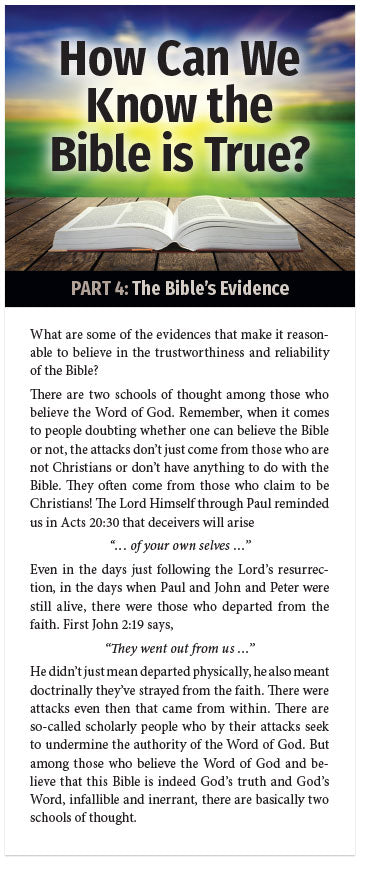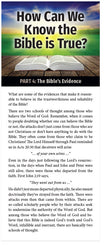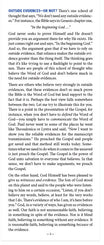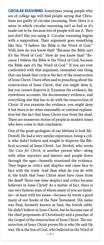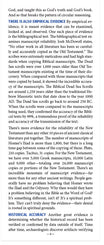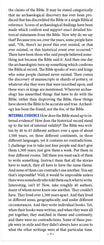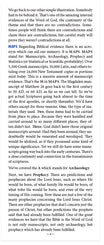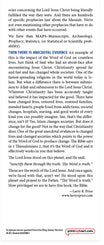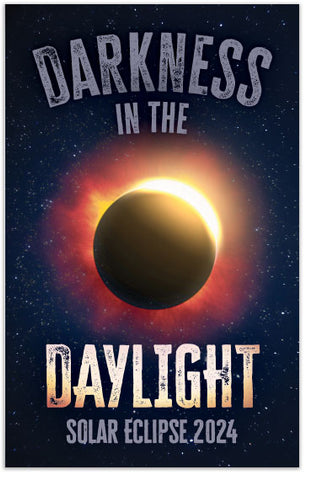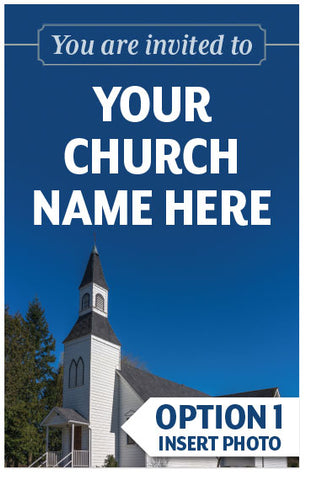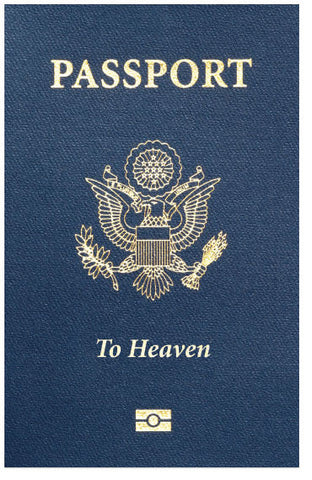How Can We Know The Bible Is True? (Part 4 of 5)
Special-Order Folded Flyer Tract
 NOTE: This item is custom-printed to order (click for more details).
NOTE: This item is custom-printed to order (click for more details).
This tract is from our print-on-demand library, and is not kept in stock. Select the options below, and we will custom-print a batch just for you. Because this item is custom-printed, you can add your custom imprint to the back page at no extra cost.
- Estimated shipping date: Wednesday, January 7 (Click for more details)
- SKU:
- Discounts: Discount coupons do not apply to this item
- Format: Folded Flyer Tract
- Size: 3.5 inches x 8.5 inches
- Pages: 8
- Imprinting: Available with 5 lines of custom text
- Version: KJV
- Returns: Because this item is custom-printed to order, it cannot be returned.
Show all item details
The full text of this flyer tract is shown below in the KJV version. (Do you want to print this tract in a different version than the one listed? Contact us and let us know what you're looking for—we may be able to create the alternate version for you at no charge.)
What are some of the evidences that make it reasonable to believe in the trustworthiness and reliability of the Bible?
There are two schools of thought among those who believe the Word of God. Remember, when it comes to people doubting whether one can believe the Bible or not, the attacks don’t just come from those who are not Christians or don’t have anything to do with the Bible. They often come from those who claim to be Christians! The Lord Himself through Paul reminded us in Acts 20:30 that deceivers will arise
“… of your own selves …”
Even in the days just following the Lord’s resurrection, in the days when Paul and John and Peter were still alive, there were those who departed from the faith. First John 2:19 says,
“They went out from us …”
He didn’t just mean departed physically, he also meant doctrinally they’ve strayed from the faith. There were attacks even then that came from within. There are so-called scholarly people who by their attacks seek to undermine the authority of the Word of God. But among those who believe the Word of God and believe that this Bible is indeed God’s truth and God’s Word, infallible and inerrant, there are basically two schools of thought.
Outside Evidences—Or Not? There’s one school of thought that says, “We don’t need any outside evidences.” For instance, the Bible says in Genesis chapter one,
“In the beginning God …”
God never seeks to prove Himself and He doesn’t provide you an argument there for why He exists. He just comes right out and says, “In the beginning God.” And so, the argument goes that if we have to rely on outside evidence, that reliance makes the outside evidence greater than the thing itself. The thinking goes that it’s like trying to use a flashlight to point to the sun. There are people of this school of thought who believe the Word of God and don’t believe much in the need for outside evidences.
There are others who believe very strongly in outside evidences, that these evidences don’t so much prove the Bible is the Word of God but lend support to the fact that it is. Perhaps the best view falls somewhere between the two. Let me try to illustrate this for you. There is a point in the presentation of the Gospel, for instance, when you don’t have to defend the Word of God—you simply have to communicate the Word of God. Paul never went to some of the places he went like Thessalonica or Lystra and said, “Now I want to show you the reliable evidences for the manuscript transmissions.” He preached the Gospel and people got saved and that method still works today. Sometimes what we need to do when it comes to the unsaved is just preach the Gospel. The Gospel is the power of God unto salvation to everyone that believes. In that sense, we don’t have to make arguments; we preach the Gospel.
On the other hand, God Himself has been pleased to give us witnesses and evidence. The Son of God stood on this planet and said to the people who were listening to him on a certain occasion, “Listen, if you don’t believe my words, believe, at least for the very works that I do. There’s evidence of who I am, it’s here before you.” God, in a variety of ways, has given us evidences as well. Our faith is not unreasonable faith, believing in something in spite of the evidence. Nor is it blind faith, believing in something without any evidence. It is reasonable faith, believing in something because of the evidence.
Circular Reasoning Sometimes young people who are of college age will find people saying that Christians are guilty of circular reasoning. Now, there is a sense in which circular reasoning isn’t as bad as it’s made out to be, because lots of people will use it. They just don’t like you using it. Circular reasoning begins with a supposition. Their argument goes something like this: “I believe the Bible is the Word of God.” Well, how do you know that? “Because the Bible says it’s the Word of God.” How do you know that? “Because I believe the Bible is the Word of God, because the Bible says it’s the Word of God.” If you are ever confronted with that argument, remember one thing that can break that cycle is the fact of the resurrection of Jesus Christ. I have often said in preaching about the resurrection of Jesus Christ, that you might deny it, but you cannot disprove it. Examine the evidence, the eyewitness accounts, the documentary evidence, and everything else that has to do with the resurrection of Christ. If you examine the evidence, you might deny it but there is no other reasonable or rational explanation but the fact that Jesus Christ rose from the dead. There are numerous stories of people in modern times who have come to that conclusion.
One of the great apologists of our lifetime is Josh McDowell. He had a very similar experience, being a critic who didn’t believe and sought to disprove the Biblical account of Jesus Christ. Lee Strobel, who wrote The Case for Christ, is another person who—along with other reporters and lawyers and people down through the ages—honestly examined the evidence. They began as critics and skeptics and came face to face with the truth. And then what do you do with it, the truth that Jesus Christ must have risen from the dead? These one-time skeptics and critics became believers in Jesus Christ! As a matter of fact, there is one very famous man of whom many of you are familiar—at least with his name—because he wrote a good many of our books of the New Testament. His name was Paul, formerly known as Saul, the Jewish rabbi. He didn’t believe in Jesus Christ, but he became one of the chief proponents of Christianity and a preacher of the Gospel of the resurrection of Jesus Christ. The resurrection of Jesus Christ proves He is who He said He was. He is the Son of God, who believed in the Word of God, and taught this as God’s truth and God’s book. And so that breaks the pattern of circular reasoning.
There Is Also Empirical Evidence By empirical evidence, it is meant evidence that can be examined, looked at, and observed. One such piece of evidence is the bibliographical test. The bibliographical test examines manuscript reliability. Josh McDowell states, “No other work in all literature has been so carefully and accurately copied as the Old Testament.” The scribes were extremely meticulous and had high standards when copying Biblical manuscripts. The Dead Sea scrolls were over 1,000 years older than Old Testament manuscripts existing at the time of their discovery. When compared with those manuscripts that were copied by hand, it showed the incredible accuracy of the manuscripts. The Biblical Dead Sea Scrolls are around 1,250 years older than the traditional Hebrew Masoretic texts that date close to the year 1000 AD. The Dead Sea scrolls go back to around 250 BC. When the scrolls were compared to the manuscripts being used, they confirmed the accuracy of the Biblical texts by 99%, a tremendous proof of the reliability and accuracy of the transmission of the text.
There’s more evidence for the reliability of the New Testament than any other 10 pieces of ancient classical literature put together. The number of manuscripts of Homer’s Iliad is more than 1,800, but there is a long time gap between some of the copying of those. Plato, 210 copies. Tacitus, 31 copies. For the New Testament, we have over 5,000 Greek manuscripts, 10,000 Latin and 9,000 other—totaling over 24,000 manuscript copies or portions of the New Testament. There’s an incredible mountain of manuscript evidence—far more than for any other ancient writings. People generally have no problem believing that Homer wrote the Iliad and the Odyssey. Why then would they have a problem believing in the Bible as the Word of God? It’s something different, isn’t it? It’s a spiritual problem. They can’t truly deny the evidence—their denial is rooted in spiritual grounds.
Historical Accuracy Another great evidence is determining whether the historical record has been verified or confirmed by data outside of itself. Time after time, archaeologists discover artifacts verifying the claims of the Bible. It may be stated categorically that no archaeological discovery has ever been produced that has discredited the Bible or a single Biblical reference. Scores of archaeological findings have been made which confirm and support exact detailed historical statements from the Bible. Now why do we say that? Because you see, over the years, some people have said, “Oh, there’s no proof this ever existed, or that ever existed, or this historical event ever occurred.” There have been those who said people believed something just because the Bible said it. And then one day the archaeologists turn up something which confirms the Biblical record. The Bible speaks of wars and kings who some people claimed never existed. Then comes the discovery of manuscripts or shards of pottery, or whatever else they were that were inscribed upon, and these wars or kings are mentioned. Wherever archaeology has unearthed things that have to do with the Bible, rather than disproving the Bible, these things have shown the Bible to be accurate and true. Archeology has been the friend, not the foe, of the Bible.
Internal Evidence How does the Bible stand up to internal evidence? How does the historical record stand up to the test of internal validity? The Bible was written by 40 to 45 different authors over a span of about 1,500 years, on three different continents, in three different languages, yet it contains no contradictions. I challenge you to take just four people and don’t give them 1,500 years, just give them a week. Put them in four different rooms. Tell them you want each of them to write something. Instruct them that all the stories have to match, they all have to have the same theme. And none of them can contradict one another. You say that’s impossible? Well, it would be impossible unless there were somebody who told them each what to write. Interesting, isn’t it? Now, take roughly 40 authors, many of whom never knew one another. They couldn’t have. They lived over 1,500 years apart. And they lived in different areas, geographically, and under different circumstances. And they write individual books. Yet, when their books were written, and when they were all put together, they matched in theme and continuity, and there were no contradictions. Some of these people were in exile and they didn’t always have access to what the other writings were at that particular time. We go back to our other simple illustration. Somebody had to be behind it. That’s one of the amazing internal evidences of the Word of God, the continuity of the theme and that there are no contradictions. Sometimes people will think there are contradictions and claim there are contradictions, but careful study will prove they weren’t contradictions at all.
MAPS Regarding Biblical evidence there is an acronym which can aid our memory. It is MAPS. MAPS stand for: Manuscripts, Archaeology, Prophecy and Statistics (or Statistical or Scientific probability). Over 5,300 Greek manuscripts, 10,000 Latin, and others totaling over 24,000 New Testament copies or portions exist today. This is a massive amount of manuscript evidence. That’s the M in MAPS. The Magdalen manuscript of Matthew 26 goes back to the first century to 50 AD, or 60 AD, as far as we can tell. So we’ve got actual Scriptures going back almost to the time of the first apostles, or shortly thereafter. We’d have others except for three reasons. One, the type of materials they used. Two, these items had to be carried from place to place. Because they were handled and carried around to so many different places, they often didn’t last. Three, God didn’t leave those original manuscripts around. Had they been around, they undoubtedly would be venerated and worshiped. They would be idolized, as if they possessed some kind of unique significance. Yet we still do have some manuscripts going way back into the early centuries. There’s a close continuity and connection in the transmission of scriptures.
We’ve covered the A which stands for Archaeology.
Next, we have Prophecy. There are predictions and prophecies about the Lord Jesus, such as where He would be born, of what family He would be born, of what tribe He would be born, and even of the very timing of His coming. Now these are just a few of the many prophecies concerning the Lord Jesus Christ. There are other prophecies that don’t concern just the person of Christ, but other predictions the prophets said that had already been fulfilled. One of the great evidences we have that the Bible is the Word of God is not only manuscripts, not only archaeology, but prophecy which has already been fulfilled.
This leads us to think about the S in our acronym, and that is Statistical Probability. By statistical probability, we mean when we take any prophecy, such as the prediction that Jesus would be a descendant of David, the odds of that happening without God doing something miraculous is one in 10,000. The odds that He would be born in the specific city of Bethlehem, one in 100,000. That he would present himself as a king, riding on a donkey, one in a million. And on and on it goes until it gets to the point beyond our ability to comprehend. The Word of God kind of paints itself into a corner, making the likelihood of anybody ever fulfilling these prophecies more and more difficult without some miraculous occurrence.
Let’s begin with a general prophecy. In the book of Genesis there is the first prophecy of the coming of a deliverer. It is called the protoevangelium, which means this is the first mention of the Gospel. It is found in Genesis chapter three, where it is stated that the seed of the woman would “bruise the head” of satan. The Messiah would be the seed of the woman. Well, the whole human race sprang from her, so it could have been anybody, couldn’t it? But by the time we get to the end of the book of Genesis it’s narrowed down that he must come from the tribe of Judah. You see, the prophecies get more and more specific and more and more detailed and more and more difficult for any one person to be able to fulfill. By the time we come to the actual fulfillment that occurred in the life of the Lord Jesus, historically, the statistical probability of just eight of the specific prophecies being precisely fulfilled is something like 1017. You take just eight of the specific prophecies, such as the very city in which He was to be born, or Him riding on a donkey—eight of those specific prophecies. The statistical probability of those being fulfilled precisely is just one chance in 1017 (that’s 1 followed by 17 zeros). Here is how this has been illustrated. Take the state of Texas, one of the largest states in the United States, and cover the state of Texas with silver dollars. 10 to the 17th power amount of silver dollars would cover the state of Texas two feet deep. Now take one of the silver dollars and paint it black and then mix them all up. Blindfold a man and tell him he has one choice, one pick to choose the right one. That’s the odds of just eight of the prophecies concerning the Lord Jesus Christ being literally fulfilled the way they were. And there are hundreds of specific prophecies just about the Messiah. We’re not even mentioning other prophecies that have to do with other events that have occurred.
We have then MAPS–Manuscripts, Archaeology, Prophecy, Statistics, (or Statistical or Scientific probability).
Then There Is Anecdotal Evidence An example of this is the impact of the Word of God on countless lives. Just think of Saul who had an about-face after encountering Jesus Christ. Christianity spread far and fast and has changed whole societies. One of the fastest-spreading religions in the world today is Islam. But what a difference there is between submission to Allah and submission to the Lord Jesus Christ. Wherever Christianity has been accurately taught and believed it has impacted for the good. There have been changed lives, restored lives, restored families, mended hearts, people freed from addictions, societal changes, hospitals, nursing, and good works of every kind you can possibly imagine. See, that’s the difference, isn’t it? Yes, Islam changes societies. But does it change for the good? Not in the way that Christianity does. One of the great anecdotal evidences is changed lives and changed societies which points to the power of the Word of God to produce change. The Bible says in 1 Thessalonians 2, that it’s the Word of God and it effectively works in you that believe.
The Lord Jesus stood on this planet, and He said,
“Sanctify them through thy truth. Thy Word is truth.”
Those are the words of the Lord Jesus. And once again, we’re faced with that, aren’t we? He stood upon this planet and prayed to the Father, “Thy Word is truth.” How privileged we are to have this book, the Bible.
—Larry R. Price
www.larryrprice.com

